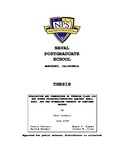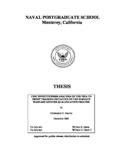Team 1: Small Unmanned Ground Vehicles (SUGV): Contribution to Small Combat Unit Combat Effectiveness
| dc.contributor.author | Geren, Richard | |
| dc.contributor.author | Richkowski, David | |
| dc.contributor.author | Foo, Kong Pin | |
| dc.contributor.author | McDonald, Mary | |
| dc.contributor.author | Pearman, Jerry | |
| dc.contributor.author | Donnelly, Thomas | |
| dc.contributor.author | Vance, Richard | |
| dc.contributor.author | Kiesling, Tobias | |
| dc.date | April 2008 | |
| dc.date.accessioned | 2013-08-28T23:11:04Z | |
| dc.date.available | 2013-08-28T23:11:04Z | |
| dc.date.issued | 2008-04 | |
| dc.identifier.uri | https://hdl.handle.net/10945/35635 | |
| dc.description | from Scythe : Proceedings and Bulletin of the International Data Farming Community, Issue 4 Workshop 16 | en_US |
| dc.description.abstract | As part of the Army’s current transformation, robots are being integrated into force structure to reduce human risk. These mechanical “battle buddies” are being used for a myriad of tasks; however, there are currently no established standards for measuring and evaluating their contribution to force combat effectiveness. This research attempts to establish some metrics using essential elements of analysis (EEA), a SUGV functional decomposition hierarchy, Measures of Effectiveness (MOEs) and Measures of Performance (MOPs). Using these metrics, we will determine if the increased situational awareness provided by SUGVs and attached sensors improves combat effectiveness and mission accomplishment. The primary SUGV functional capabilities (Figure 1) modeled were Gain Information (detect/identify agents), Move (speed), Survive (vulnerability), and Employ Effects (sensor ranges). The MOEs measured were the number of friendly forces killed (separating SUGVs and Soldiers), the number of enemy forces killed, and the overall combat effectiveness of the Small Combat Unit (SCU). Pythagoras, an agent-based modeling program was used to develop the simulation. The scenario was based on a dismounted infantry platoon conducting building clearing operations as part of a larger company level cordon and search mission in an urban environment. For comparison, excursions either included one SUGV or none. It is our hope that results obtained will be beneficial to the U.S. armed forces for subsequent research or implementation into any military tactics, techniques, or procedures (TTPs) involving our new “battle buddies”. | en_US |
| dc.rights | This publication is a work of the U.S. Government as defined in Title 17, United States Code, Section 101. Copyright protection is not available for this work in the United States. | en_US |
| dc.title | Team 1: Small Unmanned Ground Vehicles (SUGV): Contribution to Small Combat Unit Combat Effectiveness | en_US |
| dc.type | Article | en_US |





